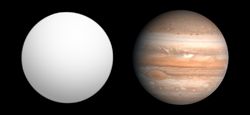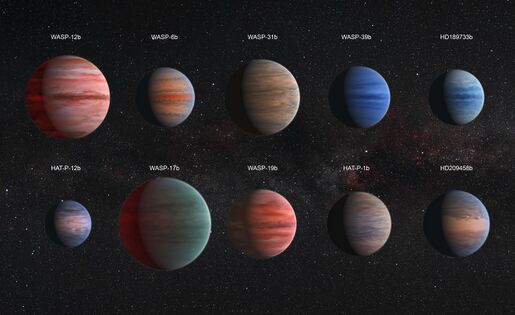Astronomy:HAT-P-12b
 Size comparison of HAT-P-12b with Jupiter. | |
| Discovery[1] | |
|---|---|
| Discovered by | Hartman et al. |
| Discovery site | Cambridge, Massachusetts |
| Discovery date | April 29, 2009 |
| Transit | |
| Designations | |
| Puli[2] | |
| Orbital characteristics | |
| 0.0384 ± 0.0003 AU (5,745,000 ± 45,000 km)[1] | |
| Eccentricity | 0 (assumed)[1] |
| Orbital period | 3.2130598 ± 0.0000021[1] d |
| Inclination | 89.0 ± 0.4[1] |
| Star | HAT-P-12 |
| Physical characteristics | |
| Mean radius | 0.959 ± 0.029[1] |♃|J}}}}}} |
| Mass | 0.211 ± 0.012[1] |♃|J}}}}}} |
| Mean density | 295 ± 25 kg/m3 (497 ± 42 lb/cu yd)[1] |
HAT-P-12b, formally named Puli,[2] is an extrasolar planet approximately 468 light years away from Earth, orbiting the 13th magnitude K-type star HAT-P-12, which is located in Canes Venatici constellation. It is a transiting hot Jupiter that was discovered by the HATNet Project on April 29, 2009.
HAT-P-12b is a H/He-dominated gas giant planet with a core mass of 11.3+2.6−2.1 M🜨 and is moderately irradiated by its low-metallicity host star.[3] Therefore, HAT-P-12b is most likely an H/He-dominated planet with a core of perhaps ~10 M🜨, and a total metal fraction of ~15%. This makes HAT-P-12b the least massive H/He-dominated gas giant planet found to date; the previous record holder was Saturn.[1]
In 2020, the obtained transmission spectra have revealed that the atmosphere of HAT-P-12b is cloudy,[4] with haze above cloud tops. Water was detected.[5] The prevalence of clouds and hazes in planetary atmosphere was disputed in 2021 though.[6]
In August 2022, this planet and its host star were included among 20 systems to be named by the third NameExoWorlds project.[7] The approved names, proposed by a team from Hungary, were announced in June 2023. HAT-P-12b is named Puli and its host star is named Komondor, after the Hungarian Puli and Komondor dog breeds.[2]
References
- ↑ 1.0 1.1 1.2 1.3 1.4 1.5 1.6 1.7 1.8 Hartman, J. D. et al. (2009). "HAT-P-12b: A Low-density sub-Saturn mass planet transiting a metal-poor K dwarf". The Astrophysical Journal 706 (1): 785–796. doi:10.1088/0004-637X/706/1/785. Bibcode: 2009ApJ...706..785H.
- ↑ 2.0 2.1 2.2 "2022 Approved Names". IAU. https://www.nameexoworlds.iau.org/2022approved-names.
- ↑ Lee, Jae Woo; Youn, Jae-Hyuck; Kim, Seung-Lee; Lee, Chung-Uk; Hinse, Tobias Cornelius (2012). "THE SUB-SATURN MASS TRANSITING PLANET HAT-P-12b". The Astronomical Journal 143 (4): 95. doi:10.1088/0004-6256/143/4/95. Bibcode: 2012AJ....143...95L.
- ↑ Yan, F.; Espinoza, N.; Molaverdikhani, K.; Henning, Th.; Mancini, L.; Mallonn, M.; Rackham, B. V.; Apai, D. et al. (2020), "LBT transmission spectroscopy of HAT-P-12b: confirmation of a cloudy atmosphere with no significant alkali features", Astronomy & Astrophysics A98: 642, doi:10.1051/0004-6361/201937265, Bibcode: 2020A&A...642A..98Y
- ↑ Wong, Ian; Benneke, Björn; Gao, Peter; Knutson, Heather A.; Chachan, Yayaati; Henry, Gregory W.; Deming, Drake; Kataria, Tiffany et al. (2020). "Optical to near-infrared transmission spectrum of the warm sub-Saturn HAT-P-12b". The Astronomical Journal 159 (5): 234. doi:10.3847/1538-3881/ab880d. Bibcode: 2020AJ....159..234W.
- ↑ Jiang, C.; Chen, G.; Pallé, E.; Murgas, F.; Parviainen, H.; Yan, F.; Ma, Y. (2021), "Evidence for stellar contamination in the transmission spectra of HAT-P-12b", Astronomy & Astrophysics 656: A114, doi:10.1051/0004-6361/202141824, Bibcode: 2021A&A...656A.114J
- ↑ "List of ExoWorlds 2022". IAU. 8 August 2022. https://www.nameexoworlds.iau.org/2022exoworlds.
External links
Coordinates: ![]() 13h 57m 434s, +43° 29′ 37″
13h 57m 434s, +43° 29′ 37″
 |


